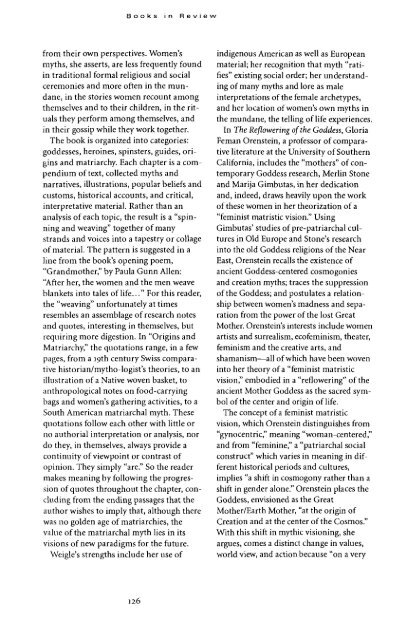To All Appearances A Lady - University of British Columbia
To All Appearances A Lady - University of British Columbia
To All Appearances A Lady - University of British Columbia
You also want an ePaper? Increase the reach of your titles
YUMPU automatically turns print PDFs into web optimized ePapers that Google loves.
Books in Review<br />
from their own perspectives. Women's<br />
myths, she asserts, are less frequently found<br />
in traditional formal religious and social<br />
ceremonies and more <strong>of</strong>ten in the mundane,<br />
in the stories women recount among<br />
themselves and to their children, in the rituals<br />
they perform among themselves, and<br />
in their gossip while they work together.<br />
The book is organized into categories:<br />
goddesses, heroines, spinsters, guides, origins<br />
and matriarchy. Each chapter is a compendium<br />
<strong>of</strong> text, collected myths and<br />
narratives, illustrations, popular beliefs and<br />
customs, historical accounts, and critical,<br />
interpretative material. Rather than an<br />
analysis <strong>of</strong> each topic, the result is a "spinning<br />
and weaving" together <strong>of</strong> many<br />
strands and voices into a tapestry or collage<br />
<strong>of</strong> material. The pattern is suggested in a<br />
line from the book's opening poem,<br />
"Grandmother," by Paula Gunn <strong>All</strong>en:<br />
"After her, the women and the men weave<br />
blankets into tales <strong>of</strong> life..." For this reader,<br />
the "weaving" unfortunately at times<br />
resembles an assemblage <strong>of</strong> research notes<br />
and quotes, interesting in themselves, but<br />
requiring more digestion. In "Origins and<br />
Matriarchy," the quotations range, in a few<br />
pages, from a 19th century Swiss comparative<br />
historian/mytho-logist's theories, to an<br />
illustration <strong>of</strong> a Native woven basket, to<br />
anthropological notes on food-carrying<br />
bags and women's gathering activities, to a<br />
South American matriarchal myth. These<br />
quotations follow each other with little or<br />
no authorial interpretation or analysis, nor<br />
do they, in themselves, always provide a<br />
continuity <strong>of</strong> viewpoint or contrast <strong>of</strong><br />
opinion. They simply "are." So the reader<br />
makes meaning by following the progression<br />
<strong>of</strong> quotes throughout the chapter, concluding<br />
from the ending passages that the<br />
author wishes to imply that, although there<br />
was no golden age <strong>of</strong> matriarchies, the<br />
value <strong>of</strong> the matriarchal myth lies in its<br />
visions <strong>of</strong> new paradigms for the future.<br />
Weigle's strengths include her use <strong>of</strong><br />
indigenous American as well as European<br />
material; her recognition that myth "ratifies"<br />
existing social order; her understanding<br />
<strong>of</strong> many myths and lore as male<br />
interpretations <strong>of</strong> the female archetypes,<br />
and her location <strong>of</strong> women's own myths in<br />
the mundane, the telling <strong>of</strong> life experiences.<br />
In The Reflowering <strong>of</strong> the Goddess, Gloria<br />
Feman Orenstein, a pr<strong>of</strong>essor <strong>of</strong> comparative<br />
literature at the <strong>University</strong> <strong>of</strong> Southern<br />
California, includes the "mothers" <strong>of</strong> contemporary<br />
Goddess research, Merlin Stone<br />
and Marija Gimbutas, in her dedication<br />
and, indeed, draws heavily upon the work<br />
<strong>of</strong> these women in her theorization <strong>of</strong> a<br />
"feminist matristic vision." Using<br />
Gimbutas' studies <strong>of</strong> pre-patriarchal cultures<br />
in Old Europe and Stone's research<br />
into the old Goddess religions <strong>of</strong> the Near<br />
East, Orenstein recalls the existence <strong>of</strong><br />
ancient Goddess-centered cosmogonies<br />
and creation myths; traces the suppression<br />
<strong>of</strong> the Goddess; and postulates a relationship<br />
between women's madness and separation<br />
from the power <strong>of</strong> the lost Great<br />
Mother. Orenstein's interests include women<br />
artists and surrealism, ec<strong>of</strong>eminism, theater,<br />
feminism and the creative arts, and<br />
shamanism—all <strong>of</strong> which have been woven<br />
into her theory <strong>of</strong> a "feminist matristic<br />
vision," embodied in a "reflowering" <strong>of</strong> the<br />
ancient Mother Goddess as the sacred symbol<br />
<strong>of</strong> the center and origin <strong>of</strong> life.<br />
The concept <strong>of</strong> a feminist matristic<br />
vision, which Orenstein distinguishes from<br />
"gynocentric," meaning "woman-centered,"<br />
and from "feminine," a "patriarchal social<br />
construct" which varies in meaning in different<br />
historical periods and cultures,<br />
implies "a shift in cosmogony rather than a<br />
shift in gender alone." Orenstein places the<br />
Goddess, envisioned as the Great<br />
Mother/Earth Mother, "at the origin <strong>of</strong><br />
Creation and at the center <strong>of</strong> the Cosmos."<br />
With this shift in mythic visioning, she<br />
argues, comes a distinct change in values,<br />
world view, and action because "on a very<br />
126

















